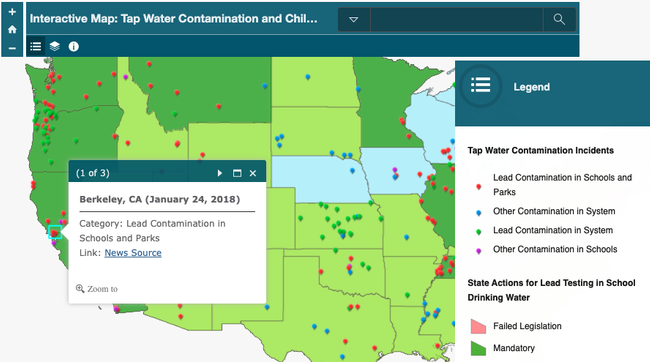Drinking water safety, especially for children, has become an issue of heightened concern since the water crisis in Flint, Michigan, in 2014.
The National Drinking Water Alliance map has recently been updated to add over 235 new points linking to news reports of tap water contamination, with nearly half of the incidents emerging since 2019.
“We created the map to help community members, advocates and decision-makers visualize the tap water contamination landscape, particularly for incidents of lead that exceed state action levels,” said Christina Hecht, UC Nutrition Policy Institute senior policy advisor and National Drinking Water Alliance coordinator.
Residents can zoom in on their state to check for contamination incidents that were reported in the news. Red pins indicate lead contamination in schools and parks. Clicking on a pin on the map produces a pop-up box containing the name of the town, date and link to the news story.
“Although most tap water is safe for drinking, the number of dots on the map show that there are times and places where tap water is not safe,” Hecht said. “The only way to know if tap water has elevated lead is by testing through an accredited lab.”
The interactive map was created by the Nutrition Policy Institute and Informatics and Geographic Information System at the University of California Agriculture and Natural Resources. The map only includes tap water contamination with lead and contaminants regulated by the U.S. Environmental Protection Agency. For example, reports of perfluoroalkyl substances, or PFAS, contaminating drinking water are not included because PFAS are not regulated by the EPA.
Although a few states now maintain some type of online database of results from school or childcare tests for lead in tap water, to date, there is no national database of lead exceedances in school or childcare drinking water.
The National Drinking Water Alliance map includes information on state policies and programs to test for lead in school drinking water. Almost one-third of U.S. states have enacted legislation providing policy to test for lead in drinking water in schools and, in some cases, in child-care centers. California tests for lead in drinking water at all public K-12 schools and posts the results online. Policies for mandatory testing have recently passed in Oregon and Vermont. New legislation has been proposed in Wisconsin, Iowa, Nebraska and Connecticut. Voluntary programs are now present in every state, funded by nationwide federal grants supporting testing in child-care facilities and schools.
More information on each state's actions can be found on the interactive map at www.drinkingwateralliance.org/new-map, which was updated by Nutrition Policy Institute intern Laurel Denyer, a recent UC Davis graduate.
For more information about drinking water safety, and to propose additions to the map, please contact the NDWA at DWAalliance@ucanr.edu.

